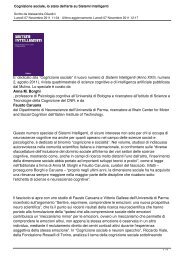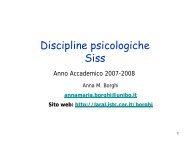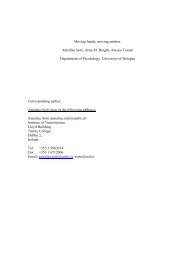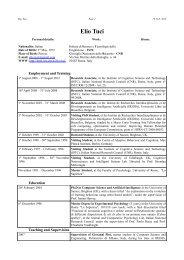Evolution of Artificial Neural Networks - laral
Evolution of Artificial Neural Networks - laral
Evolution of Artificial Neural Networks - laral
Create successful ePaper yourself
Turn your PDF publications into a flip-book with our unique Google optimized e-Paper software.
Nolfi and Parisi, <strong>Evolution</strong> <strong>of</strong> <strong>Artificial</strong> <strong>Neural</strong> <strong>Networks</strong> 2A cornerstone <strong>of</strong> biology is the distinction between inherited genetic code(genotype) and the corresponding organism (phenotype). What is inherited fromthe parents is the genotype. The phenotype is the complete individual that isformed according to the instructions specified in the genotype.<strong>Evolution</strong> is critically dependent on the distinction between genotype andphenotype, and on their relation, i.e. the genotype-to-phenotype mapping. Thefitness <strong>of</strong> an individual, that affect selective reproduction, is based on thephenotype, but what is inherited is the genotype, not the phenotype. Furthermore,while the genotype <strong>of</strong> an individual is one single entity, the organism can beconsidered as a succession <strong>of</strong> different phenotypes taking form during thegenotype-to-phenotype mapping process, each derived from the previous oneunder genetic and environmental influences.When the genotype-to-phenotype mapping process takes place duringindividuals' lifetime we can talk <strong>of</strong> development. In this case, each successivephenotype, corresponding to a given stage <strong>of</strong> development, has a distinct fitness.The total fitness <strong>of</strong> a developing individual is a complex function <strong>of</strong> thesedevelopmental phases. <strong>Evolution</strong> must ensure that all these successive forms areviable and, at the same time, that they make a well-formed sequence where eachform leads to the next one until a mostly stable (adult) form is reached. This putsvarious constraints on evolution but it also <strong>of</strong>fers new means for exploringnovelty. Small changes in the developmental rates <strong>of</strong> different components <strong>of</strong> thephenotype, for example, can have huge effects on the resulting phenotype. Indeedit has been hypothesized that in natural evolution changes affecting regulatorygenes that control the rates <strong>of</strong> development played a more important role thanother forms <strong>of</strong> change such as point mutations (Gould, 1977).Although the role <strong>of</strong> the genotype-to-phenotype mapping and <strong>of</strong> developmenthas been ignored in most <strong>of</strong> the experiments involving artificial evolution, there isnow an increasing awareness <strong>of</strong> its importance. Wagner & Altenberg (1996)write: "In evolutionary computer science it was found that the Darwinian process<strong>of</strong> mutation, recombination and selection is not universally effective in improvingcomplex systems like computer programs or chip designs. For adaptation tooccur, these systems must possess evolvability, i.e. the ability <strong>of</strong> randomvariations to sometimes produce improvement. It was found that evolvabilitycritically depends on the way genetic variation maps onto phenotypic variation, anissue known as the representation problem." (p. 967).Genetic EncodingTo evolve neural networks one should decide how to encode the network in thegenotype in a manner suitable for the application <strong>of</strong> genetic operators. In most















